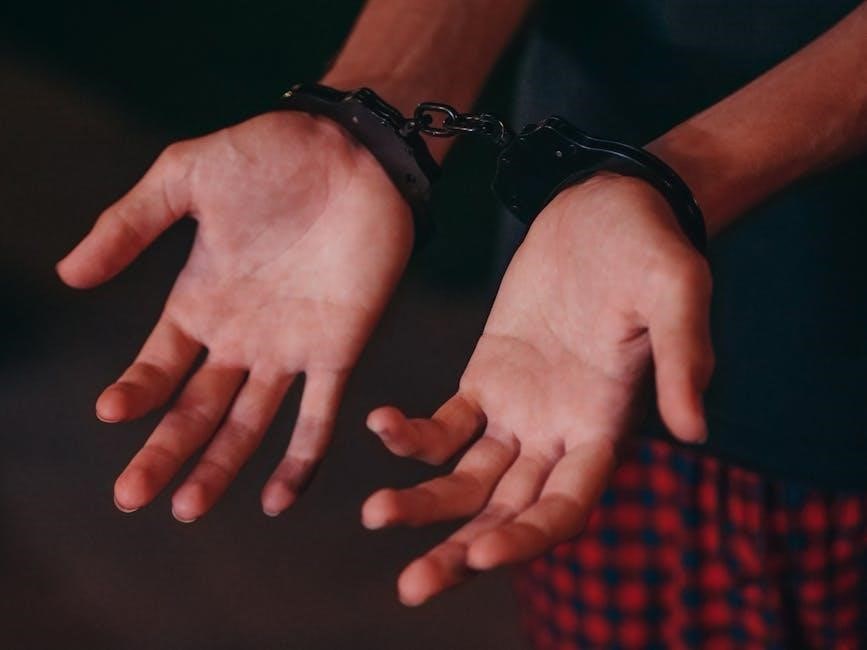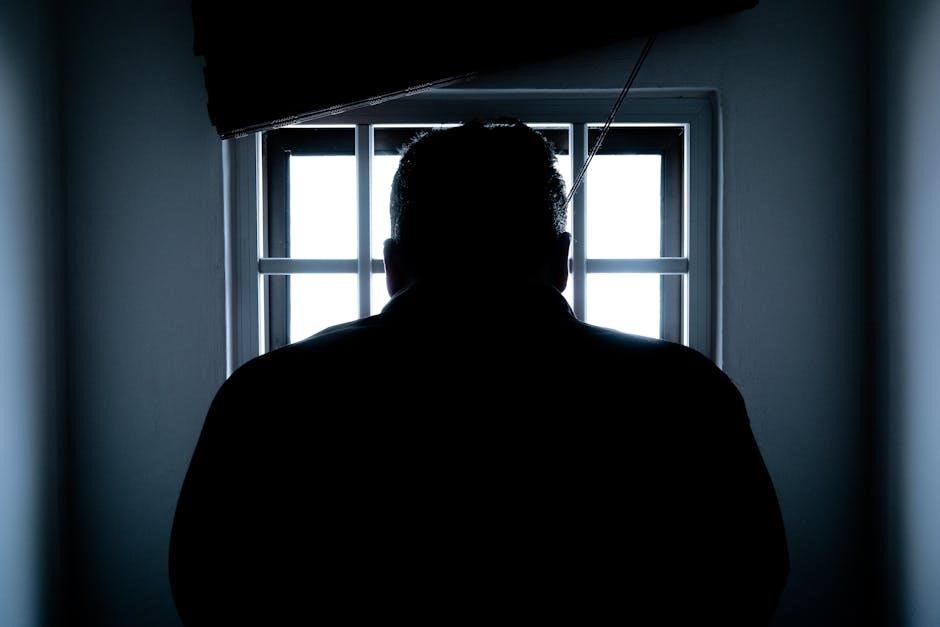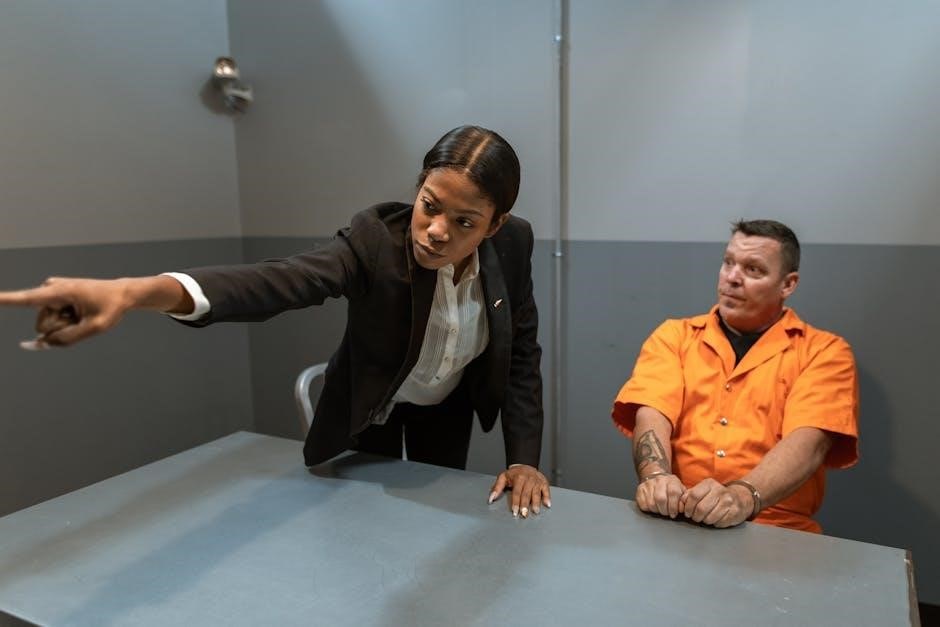The criminal justice system is a framework designed to maintain social order, enforce laws, and deliver justice through fair processes and institutions.
1.1. Definition and Scope of Criminal Justice
Criminal justice refers to the system of practices, institutions, and laws aimed at upholding social order by enforcing criminal laws. It encompasses the processes of investigating crimes, prosecuting offenders, and rehabilitating or punishing them. The scope of criminal justice includes addressing crime prevention, public safety, and the fair administration of justice. It involves law enforcement agencies, courts, and correctional systems working collaboratively to maintain legal standards and protect societal well-being. Criminal justice systems vary globally but share the common goal of ensuring accountability for criminal acts while safeguarding individual rights and promoting justice.
1.2. Importance of Studying Criminal Justice
Studying criminal justice provides a deeper understanding of crime dynamics, legal frameworks, and the roles of law enforcement, judiciary, and corrections systems. It equips individuals with knowledge to address societal issues like public safety, inequality, and justice reform. Criminal justice education fosters critical thinking and problem-solving skills, preparing professionals to navigate complex legal and ethical challenges. It also highlights the importance of accountability, fairness, and rehabilitation within the justice system. By examining real-world cases and policies, students gain insights into how to reduce crime and promote social justice, making it a vital field for creating a safer and equitable society.
1.3. Overview of the Criminal Justice System
The criminal justice system is a network of institutions and processes designed to uphold the law, maintain social order, and deliver justice. It operates through three main components: law enforcement, the judiciary, and corrections. The process begins with crime investigation and arrest, followed by prosecution, trial, and sentencing. The system aims to ensure public safety, hold offenders accountable, and provide rehabilitation opportunities. It also addresses victims’ rights and seeks to prevent future crimes. The criminal justice system is dynamic, adapting to societal changes and legal reforms while striving to balance punishment, rehabilitation, and fairness in its execution of justice.

Components of the Criminal Justice System
The criminal justice system consists of three primary components: law enforcement, the judiciary, and corrections. Each plays a vital role in upholding justice and public safety.
2.1. Law Enforcement Agencies
Law enforcement agencies are responsible for maintaining public order, preventing crimes, and investigating offenses. They include local police departments, federal agencies like the FBI, and specialized units. These agencies work to enforce criminal laws, protect citizens, and ensure community safety. Their duties range from patrols and traffic control to complex investigations and counterterrorism efforts. Effective law enforcement is crucial for upholding justice and maintaining societal stability, making them the first line of defense in the criminal justice system. Their role is essential in initiating the criminal justice process through arrests and gathering evidence for prosecutions. Their work directly impacts public trust and safety.
2.2. The Judiciary
The judiciary is the branch of government responsible for interpreting laws and administering justice through courts. It includes trial courts, appellate courts, and supreme courts. Judges preside over criminal trials, ensuring legal procedures are followed and the rights of defendants are protected. The judiciary also handles civil disputes and constitutional matters. Its role is to remain impartial, applying the law to the facts presented. The judiciary ensures fairness and upholds the rule of law, acting as a check on the other branches of government. Effective judicial systems are vital for maintaining public confidence in the criminal justice system and protecting individual rights.
2.3. Corrections System
The corrections system focuses on managing individuals who have been convicted of crimes. It includes prisons, jails, and probation or parole services. The primary goals are punishment, deterrence, rehabilitation, and public safety. Prisons are for longer-term confinement, while jails often hold those awaiting trial or serving shorter sentences. Probation allows offenders to remain in the community under supervision, and parole provides supervised release after prison time. Rehabilitation programs, such as education and counseling, aim to reduce recidivism. The corrections system faces challenges like overcrowding, resource allocation, and balancing punishment with rehabilitation to prepare offenders for reintegration into society effectively.

The Criminal Justice Process
The criminal justice process involves the investigation of crimes, arrest, prosecution, trial, sentencing, and corrections. It ensures justice is served through a structured and lawful sequence of events.
3.1. Investigation and Arrest
The investigation and arrest phase is the initial stage of the criminal justice process. Law enforcement agencies gather evidence, interview witnesses, and identify suspects.
Police officers may obtain search warrants to collect physical evidence and build a case. Once sufficient evidence is gathered, suspects are arrested and taken into custody.
This phase ensures that criminal activity is thoroughly examined and that legal procedures are followed. The investigation must adhere to legal standards to protect individual rights and maintain the integrity of the case. Proper documentation and adherence to due process are critical during this phase to ensure justice is served.
3.2. Prosecution and Trial
Following investigation, the prosecution phase begins with the district attorney reviewing evidence to determine if charges should be filed.
During the trial, the prosecution presents evidence against the defendant, while the defense challenges the case.
The trial is conducted in a courtroom, where a judge or jury determines guilt or innocence.
The burden of proof lies with the prosecution, requiring evidence beyond a reasonable doubt.
If convicted, the defendant proceeds to sentencing; if acquitted, they are released. This phase ensures the accused receives a fair trial, upholding the principles of justice and accountability.
3.3. Sentencing and Punishment
Sentencing occurs after a guilty verdict, where the judge determines the appropriate punishment.
This can include incarceration, probation, fines, or community service, depending on the severity of the crime.
The goal is to punish the offender, deter future crimes, and rehabilitate them.
Factors influencing sentencing include the defendant’s criminal history, the crime’s severity, and any mitigating circumstances.
Punishment aims to uphold justice while balancing societal protection and offender rehabilitation.
3.4. Corrections and Rehabilitation
Corrections aims to manage offenders post-sentencing through incarceration or probation.
Rehabilitation focuses on helping offenders reintegrate into society by addressing underlying issues such as addiction or lack of education.
Programs include counseling, vocational training, and education to reduce recidivism.
Corrections systems balance punishment with the goal of preparing individuals for life after release.
Effective rehabilitation is crucial for both individual success and community safety.

Criminal Justice vs. Social Justice
Criminal justice addresses law violations, while social justice seeks fairness in society. Both systems aim to uphold rights but differ in focus and application methods.
4.1. Differences Between Criminal and Social Justice
Criminal justice focuses on punishing lawbreakers and maintaining order through legal processes, while social justice seeks fairness and equality in society. Criminal justice addresses individual violations, whereas social justice tackles systemic inequalities. Criminal justice is enforced by the state, while social justice often involves community advocacy and systemic change. Criminal justice is reactive, responding to crimes, whereas social justice is proactive, aiming to prevent injustices. Both systems share the goal of justice but differ in scope, methods, and objectives. Criminal justice is narrower, focusing on legality, while social justice is broader, emphasizing human rights and equitable treatment for all individuals.
4.2. Role of Criminal Justice in Social Justice
The criminal justice system plays a critical role in advancing social justice by addressing systemic inequalities and protecting vulnerable populations. It ensures accountability for violations of human rights and enforces laws that promote fairness. Criminal justice institutions, such as law enforcement and courts, must operate impartially to uphold social justice principles. Legal reforms and policies within the criminal justice system can address discrimination, inequality, and marginalization. Education and advocacy within the system further support its role in fostering a just society. By addressing root causes of injustice, criminal justice contributes to the broader goals of social justice and human dignity.

Juvenile Justice System
The juvenile justice system focuses on rehabilitation rather than punishment, addressing the unique needs of minors involved in criminal activities with a supportive framework.
5.1. Overview of the Juvenile Justice System
The juvenile justice system is designed to address criminal behavior among minors, focusing on rehabilitation rather than punishment. It operates under the belief that young offenders can be reformed through appropriate interventions. The system differs from the adult criminal justice system in its emphasis on counseling, education, and community integration. Juvenile cases typically involve unique procedures, such as juvenile courts and detention centers tailored for minors. The goal is to prevent recidivism by addressing underlying issues like family dynamics, mental health, and educational needs. This approach aims to create a supportive environment for minors to develop positively and reintegrate into society effectively.
5.2. Differences from the Adult Criminal Justice System
The juvenile justice system differs significantly from the adult criminal justice system, primarily in its focus on rehabilitation over punishment. Juvenile courts emphasize confidentiality to protect minors’ identities and futures. Proceedings are less formal, with an emphasis on counseling and community-based programs. Unlike adults, juveniles are not entitled to a jury trial, and their cases are often resolved through diversion or probation. The system also prioritizes addressing the root causes of delinquency, such as family issues or mental health, aiming to prevent future offenses. This approach reflects a commitment to helping young offenders reintegrate into society rather than imposing harsh penalties.

Ethical Issues in Criminal Justice
Ethical issues in criminal justice include ensuring fairness, reducing bias, and addressing police misconduct. Transparency and accountability are crucial to maintaining public trust and upholding justice.
6.1. Police Ethics and Use of Force
Police ethics involve upholding moral standards to ensure just and fair law enforcement. Key challenges include racial bias, excessive force, and transparency in decision-making; Use of force policies must balance officer safety with civilian rights. Training programs emphasize de-escalation techniques to minimize violence. Accountability measures, such as body cameras and civilian oversight, help address misconduct. Ethical policing fosters public trust, essential for effective community relationships. However, systemic issues persist, requiring systemic reforms to ensure equitable justice and uphold the principles of fairness and accountability within law enforcement agencies.
6.2. Ethical Considerations in Prosecution
Ethical considerations in prosecution ensure fairness and justice within the criminal justice system. Prosecutors must avoid conflicts of interest and disclose exculpatory evidence to prevent wrongful convictions. They are obligated to seek justice, not merely convictions, maintaining impartiality and integrity; Misconduct, such as withholding evidence or coercive plea bargaining, undermines public trust. Ethical training and accountability measures are crucial to uphold these standards. The role of prosecutors is pivotal in balancing legal obligations with moral responsibilities, ensuring that the rights of the accused are protected while upholding the rule of law and societal justice.
6.3. Judicial Ethics and Fair Trials
Judicial ethics are essential to maintaining the integrity of the criminal justice system, ensuring fair and impartial trials. Judges must avoid conflicts of interest and recuse themselves when necessary. Upholding procedural fairness, judges guarantee that both the prosecution and defense have equal opportunities to present their cases. Adherence to legal precedents and impartial decision-making are critical to prevent bias. Public confidence in the judiciary relies on transparent and ethical conduct. Training and accountability mechanisms help judges uphold these standards, ensuring that trials remain fair and just, thereby maintaining the legitimacy of the criminal justice process.
6.4. Ethics in Corrections and Rehabilitation
Ethics in corrections and rehabilitation focus on ensuring the humane treatment and dignity of incarcerated individuals; Correctional officers must balance security with the protection of inmates’ rights, avoiding abuse of authority. Rehabilitation programs aim to prepare offenders for reintegration into society, emphasizing ethical practices that foster personal growth and accountability. Confidentiality, transparency, and respect for diversity are key principles. Additionally, addressing mental health and substance abuse ethically is crucial to reduce recidivism. Ethical challenges include managing overcrowded facilities and balancing punishment with rehabilitation. Upholding these standards ensures that correctional systems contribute positively to societal safety and individual redemption.

Technology and Criminal Justice
Technology transforms criminal justice by enhancing forensic analysis, improving digital evidence handling, and enabling advanced surveillance, ensuring more efficient and accurate investigations and prosecutions.
7.1. Role of Forensic Science
Forensic science plays a pivotal role in criminal justice by analyzing evidence to link crimes to suspects. Techniques like DNA profiling, fingerprint analysis, and ballistics help establish facts objectively, ensuring accurate convictions and exonerating the innocent. Forensic experts use scientific methods to examine physical evidence, providing critical insights for investigations and trials. This field has revolutionized criminal investigations, making them more precise and reliable. The integration of forensic science in criminal justice enhances the integrity of legal processes, fostering trust in the system’s ability to deliver fair and just outcomes.
7.2. Digital Evidence and Cybercrime
Digital evidence, such as emails, text messages, and social media data, has become crucial in criminal investigations. Cybercrimes, including hacking and online fraud, require specialized tools to track and prosecute offenders. Digital forensics involves recovering and analyzing data from devices to uncover illegal activities. Law enforcement agencies must stay updated on technologies to combat evolving cyber threats effectively. The rise of cybercrime has necessitated global cooperation, as digital crimes often cross borders. Ensuring the integrity and security of digital evidence is vital for successful prosecutions and maintaining justice in the digital age.
7.3. Surveillance and Privacy Concerns
Surveillance technologies, such as facial recognition and GPS tracking, are increasingly used in criminal justice to monitor suspects and prevent crimes. However, these tools raise significant privacy concerns, as they can intrude on individuals’ personal lives. Balancing security and privacy is a growing challenge, with debates focusing on data collection limits and consent. Laws like the Fourth Amendment aim to protect against unreasonable searches, but digital surveillance often tests these boundaries. Ensuring transparency and accountability in surveillance practices is essential to maintaining public trust while effectively combating crime in the digital era.

Global Perspectives on Criminal Justice
Global criminal justice systems vary widely, reflecting diverse legal frameworks and cultural values. International cooperation and comparative studies highlight differences in crime prevention and punishment approaches worldwide.
8.1. International Criminal Courts
International criminal courts are established to prosecute individuals for crimes such as genocide, war crimes, and crimes against humanity. These courts operate under international law, ensuring accountability for global atrocities. The International Criminal Court (ICC) is a prominent example, functioning as a last resort when national jurisdictions fail to act. Other tribunals, like the ICTY and ICTR, were created to address specific conflicts; These courts face challenges, including gaining cooperation from states and ensuring fair trials. Their role is crucial in upholding justice and deterring future violations, promoting a global commitment to human rights and the rule of law.
8.2. Comparative Criminal Justice Systems
Comparative criminal justice systems analyze the differences and similarities in how various countries address crime and justice. Common law systems, like in the U.S., emphasize judicial precedents, while civil law systems, prevalent in Europe, rely on codified statutes. Some nations use hybrid or religious-based systems. For instance, Japan combines civil and common law, while Saudi Arabia incorporates Islamic law. These systems differ in police powers, trial processes, and corrections. Understanding these variations provides insights into cultural, legal, and historical contexts shaping justice globally, highlighting strengths and weaknesses of different approaches to crime control and human rights protections.

Emerging Trends in Criminal Justice
Emerging trends include the rise of AI in policing, cryptocurrency-related crimes, advanced forensic technologies, and growing concerns about cybersecurity and data privacy in justice systems.
9.1. The Impact of Cryptocurrency on Crime
Cryptocurrency has revolutionized financial transactions but also introduced new challenges in criminal justice. Its anonymity enables illegal activities like money laundering, drug trafficking, and cybercrimes. Law enforcement struggles to track crypto transactions, making it a haven for criminals. However, blockchain technology’s transparency also aids investigators in tracing illegal activities. The rise of cryptocurrency-related crimes necessitates updated regulations and advanced investigative tools to combat misuse while harnessing its potential for legal financial operations.
9.2. Artificial Intelligence in Law Enforcement
Artificial Intelligence (AI) is transforming law enforcement by enhancing predictive policing, crime analysis, and investigative processes. AI algorithms analyze vast datasets to identify crime patterns, enabling proactive measures to prevent offenses. Facial recognition technology aids in identifying suspects, while AI-driven tools improve evidence analysis and case management. However, ethical concerns arise regarding privacy, bias, and accountability. Despite these challenges, AI offers unprecedented opportunities to modernize law enforcement, making it more efficient and data-driven. Its integration into criminal justice systems is revolutionizing how crimes are anticipated, investigated, and resolved, promising a safer and more just society.
9.3. The Rise of Cybersecurity Threats
Cybersecurity threats have become a significant challenge in the criminal justice system, as criminals increasingly exploit digital vulnerabilities. Hackers target sensitive data, disrupt court operations, and infiltrate law enforcement systems, compromising investigations and public trust. Ransomware attacks on government agencies and critical infrastructure highlight the growing sophistication of cybercriminals. The rise of darknet markets and encrypted communication platforms further complicates efforts to combat cybercrime. Law enforcement agencies must adapt by investing in advanced cybersecurity measures and training to stay ahead of evolving threats. Addressing these challenges requires robust frameworks, international cooperation, and continuous innovation to safeguard the integrity of the criminal justice system.
9.4. The Issue of Wrongful Convictions
Wrongful convictions remain a critical concern within the criminal justice system, undermining public trust and raising ethical dilemmas. These cases often result from eyewitness misidentification, flawed forensic evidence, or prosecutorial misconduct. The Innocence Project has highlighted how DNA testing can exonerate wrongly convicted individuals, revealing systemic failures. Addressing wrongful convictions requires reforms such as improving police procedures, enhancing legal safeguards, and ensuring access to effective legal representation. Raising awareness and advocating for policy changes are essential to prevent injustices and restore faith in the criminal justice system’s ability to deliver fair and accurate outcomes for all individuals. This issue demands urgent attention and action.

Education and Careers in Criminal Justice
Criminal justice education offers diverse career opportunities, including roles in law enforcement, judiciary, and corrections, preparing professionals to uphold justice and protect communities effectively.
10.1. Importance of Criminal Justice Education
Criminal justice education is crucial for understanding the complexities of the justice system, fostering ethical practices, and preparing individuals for careers in law enforcement, judiciary, and corrections. It provides foundational knowledge of laws, procedures, and societal issues, enabling professionals to address crime effectively. Education also cultivates critical thinking and problem-solving skills, essential for navigating the evolving challenges of the field. By studying criminal justice, individuals gain insights into the interplay between justice, social equity, and community safety, equipping them to contribute meaningfully to a fair and just society.
10.2. Career Opportunities in Criminal Justice
The criminal justice field offers diverse career opportunities across law enforcement, judiciary, and corrections. Professionals can work as police officers, detectives, forensic scientists, or federal agents. Legal careers include prosecutors, defense attorneys, and judges, while corrections involve roles like probation officers and rehabilitation counselors. Cybersecurity and digital forensics are emerging fields, addressing modern crime challenges. Additionally, careers in policy-making, criminology research, and advocacy provide avenues for systemic change. With specialized skills and education, individuals can pursue leadership roles, shaping the future of justice and public safety. The demand for skilled professionals ensures a dynamic and rewarding career landscape in criminal justice.
The criminal justice system plays a vital role in maintaining societal order and justice, emphasizing the need for continuous improvement and ethical practices to ensure fairness and equality.
11.1. Summary of Key Concepts
The criminal justice system is a framework designed to maintain social order and enforce laws through fair and ethical processes. It comprises three main components: law enforcement, the judiciary, and corrections, each playing a crucial role in upholding justice; The system aims to protect society by addressing criminal behavior, ensuring accountability, and providing rehabilitation opportunities. Ethical considerations are integral to its function, emphasizing fairness and equality. Continuous improvement is necessary to address emerging challenges and enhance the delivery of justice, ensuring that the system remains effective and just in its operations and outcomes.
11.2. Future Directions in Criminal Justice
Future directions in criminal justice emphasize technological advancements, ethical reforms, and global collaboration. Innovations like AI and forensic science will enhance investigation and evidence analysis. Addressing wrongful convictions and improving transparency are critical. There is a growing focus on rehabilitation over punishment, aiming to reduce recidivism. International cooperation will strengthen responses to transnational crimes. Additionally, integrating mental health and social services into the system can address root causes of crime; Continuous education and training for professionals will ensure they meet evolving challenges. By prioritizing fairness, efficiency, and human rights, the criminal justice system can better serve society and adapt to future complexities.


